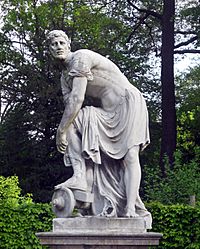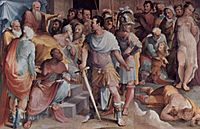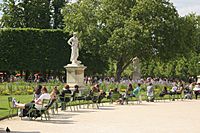Lucius Quinctius Cincinnatus facts for kids
Quick facts for kids
Lucius Quinctius Cincinnatus
|
|
|---|---|
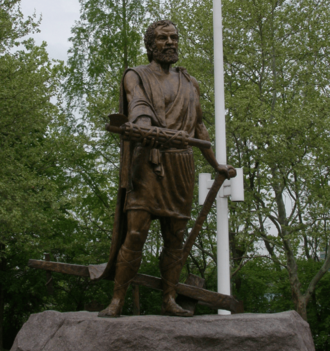
|
|
| Born | c. 519 BC |
| Died | c. 430 BC (aged c. 89) |
| Nationality | Roman |
| Office | |
| Spouse(s) | Racilia |
| Children |
|
| Family | Quinctia gens |
| Military service | |
| Battles/wars | Battle of Mount Algidus (458 BC) |
Lucius Quinctius Cincinnatus (c. 519 – c. 430 BC) was an important Roman leader from the early Roman Republic. He was a patrician, which meant he belonged to one of the powerful, noble families in Rome. He was also a statesman (a skilled politician) and a military leader. Over time, Cincinnatus became a legendary example of Roman virtue, especially for his civic virtue, meaning his dedication to his community.
Cincinnatus was known for being against the rights of the plebeians, who were the common citizens of Rome. He became poor because his son, Caeso Quinctius, strongly opposed the plebeians' wish for written laws that would apply to everyone equally. Despite his age, Cincinnatus worked on his own small farm. However, when Rome faced an invasion, his fellow citizens asked him to lead them.
He left his farm to take complete control of the state during the crisis. After winning a quick victory in just 16 days, he gave up his power and returned to his farm. This act of success and immediately stepping down from near-absolute power (around 458 BC) is often seen as a great example of leadership, serving the public good, humility, and modesty.
Today, historians question some parts of the story told by writers like Livy. However, they generally agree that Cincinnatus was a real person. He served as a consul (a top official) in 460 BC and as a dictator in 458 BC. He might have been dictator again in 439 BC. This was when the patricians asked him to stop a possible uprising by the plebeians, led by Spurius Maelius. After this, he is said to have given up his power once more.
Who Was Cincinnatus?
According to old stories, Lucius Cincinnatus was born around 519 BC, during the last years of the Roman Kingdom. He was part of the ancient patrician family called Quinctia. This family was very old, even older than Rome itself. They were moved to Rome from the city of Alba Longa by an early Roman king, Tullus Hostilius.
The first consul from this family was Titus Quinctius Capitolinus Barbatus, elected in 471 BC. Since both Titus and Lucius are recorded as sons and grandsons of men named Lucius Quinctius, some think Titus might have been Lucius's brother. Lucius was likely the first in his family to have the nickname Cincinnatus, which means "the curly haired." His family was wealthy.
Early Life and Challenges
In the late 460s BC, Rome was fighting off attacks from the Aequi people to its east. Around 462 BC, a tribune (a leader who protected the rights of common people) named G. Terentilius Harsa started pushing for written Roman laws. He wanted these laws to create a kind of constitution that would limit the great power of the patrician consuls.
In the years that followed, the plebeians' requests were often ignored or rejected. Sometimes, gangs of patricians and their supporters, supposedly including Cincinnatus's son Caeso, even beat and drove the plebeians from the streets.
The patricians' strong resistance caused a lot of trouble. This unrest allowed a person named Appius Herdonius to take over the Capitoline Hill in Rome. He held it with a group of outlaws and former slaves (according to Livy) or with an army of Sabines (according to Dionysius). The consul Publius Valerius Poplicola was killed while trying to take it back in 460 BC. Cincinnatus then became the "replacement" consul for the rest of the year.
Cincinnatus was strongly against the plebeians' law proposal, and it didn't make any progress while he was consul. His son was supposedly forced to leave Rome and was killed. Cincinnatus then left the city and went to live on his farm west of the Tiber.
Cincinnatus as Dictator
Cincinnatus served as a dictator in 458 or 457 BC. A dictator was a special leader appointed by the Roman Republic only during extreme emergencies. His job was to lead help to the Roman army, which was stuck under the consul L. Minucius Esquilinus Augurinus at Mount Algidus. Many details of this story are now thought to be made up, and some even believe the whole military account is fictional.
During his time as dictator, Cincinnatus used his power to accuse Marcus Volscius, who had accused his son, of lying under oath. Volscius was then forced to leave Rome.
Later, during a period when ten men (called decemvirs) ruled Rome, Cincinnatus tried to get a position in their government in 450 BC, but he was not successful. However, Livy mentions that Cincinnatus was involved in discussions about allowing plebeians to become consuls.
Cincinnatus might have returned as dictator in 439 BC. This was to protect Rome from a suspected plot by a wealthy plebeian named Spurius Maelius. It was thought that Maelius was trying to win over the poor to become king of Rome. When Spurius Maelius did not obey Cincinnatus's summons, he was killed by Cincinnatus's master of horse. The supposed plot then ended. Cincinnatus likely died soon after this event.
The Legend of Cincinnatus
Cincinnatus's Son, Caeso
In the traditional stories, Cincinnatus's son, Caeso, was openly against the plebeians' efforts to pass the Terentilian Law. This law aimed to write down Roman legal traditions and limit the power of the patrician consuls. Caeso would lead groups to drive the Tribunes of the Plebs from the Forum, stopping the process needed to approve the law.
Caeso was accused of serious crimes in 461 BC but was released after a large payment. A plebeian named Marcus Volscius claimed that Caeso had knocked down and injured his sick brother, who later died. Instead of facing his accusers in court, Caeso fled to the Etruscans. He was then found guilty in his absence, and his father was ordered to pay a huge fine. This forced Cincinnatus to sell most of his property and leave public life to work on a small farm. Modern historians believe the fine was likely made up later to explain Cincinnatus's supposed poverty and make his virtues seem even greater. Some historians even doubt the entire story.
His First Time as Dictator
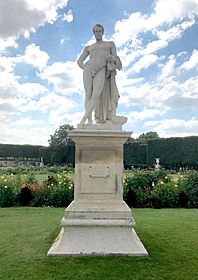
In 458 BC, the Aequi people broke their peace treaty and tried to take back Tusculum. The consuls for that year, L. Minucius Esquilinus Augurinus and G. Nautius Rutilus, led two armies. One went to help Tusculum, and the other attacked the lands of the Aequi and their Sabine allies.
When L. Minucius Esquilinus Augurinus's army reached Mount Algidus, they camped and rested instead of attacking right away. The Aequi quickly surrounded them and successfully trapped them. Only five horsemen escaped to tell the Roman Senate what had happened. With the second consul's army unable to help, the senators panicked and decided to name a dictator. G. Nautius Rutilus or Horatius Pulvillus chose Cincinnatus for a six-month term.
A group of senators was sent to Cincinnatus to tell him about his appointment. They found him plowing his farm. He asked them if everything was alright. They replied that they hoped "it might turn out well for both him and his country." They asked him to put on his senatorial toga before hearing the Senate's message. He called out to his wife, Racilia, to bring his toga from their small house. Once he was dressed, the group greeted him as dictator and ordered him to come to the city. He crossed the Tiber in one of the Senate's boats. When he arrived, his three sons and most of the senators greeted him. Several lictors (guards) were given to him for protection and to carry out his orders.
The next morning, Cincinnatus went to the Forum and named Lucius Tarquitius as his master of the horse (his second-in-command). He then went to the assembly of the people and ordered every man old enough for military service to appear on the Field of Mars by the end of the day. They were to bring twelve times the usual amount of encamping spikes. They then marched to help the trapped consul's army.
At the Battle of Mount Algidus, they used their spikes to quickly surround the Aequi who were besieging the Roman army. Instead of killing them between the two Roman camps, Cincinnatus accepted their pleas for mercy. He offered them forgiveness, but only if three main offenders were executed and their leaders, including Gracchus Cloelius, were handed over in chains. Then, a "yoke" of three spears was set up. The Aequi were made to pass under it as a sign of surrender, bowing and admitting their defeat. Cincinnatus then dismissed his army and went back to his farm, giving up his power only fifteen days after he had been given it.
His Second Time as Dictator
His brother or nephew, Titus Quinctius Capitolinus Barbatus, nominated Cincinnatus to come out of retirement for a second time as dictator in 439 BC. This was to deal with the feared plot by the wealthy plebeian Spurius Maelius. It was believed that Maelius was trying to buy the loyalty of the poor and make himself king of Rome. Cincinnatus named C. Servilius Ahala as his master of the horse and told him to bring Spurius Maelius before him. Cincinnatus and the other patricians then placed guards on the Capitoline Hill and other strong points around the city.
Maelius fought off Ahala's officer with a butcher's knife and ran into a crowd. Ahala led a group of patricians into the crowd and killed Maelius as he fled. With the crisis solved, Cincinnatus again gave up his power, having served for 21 days. (Ahala was later put on trial for going beyond his orders and chose to leave Rome voluntarily.) Different parts of this story are linked to legends that explain how things got their names, and it might not have much connection to the dictator of 458 BC, other than being from the same family.
Cincinnatus's Lasting Impact
Cincinnatus became a true legend to the Romans. He was given supreme power twice but held onto it for only as long as absolutely necessary. He always showed great honor and honesty. The high respect he earned from later Romans sometimes extended to his friends. One story from the end of his life says that a man named Capitolinus defended one of Cincinnatus's sons from a charge of not being good enough in the military. He asked the jury who would tell the old Cincinnatus the bad news if his son were found guilty. The son was said to have been found innocent because the jury couldn't bear to break the old man's heart.
Many cities in Italy have squares, streets, or other places named after Cincinnatus (Italian: Cincinnato). The Cincinnato neighborhood in Anzio, Italy, is named in his honor.
The story of Cincinnatus's military victory and his quick return to his farm has continued to inspire people. It has also been used to honor other political leaders, especially George Washington. Washington gave up control of the Continental Army, refused to become a king, and voluntarily retired after two terms as president to return to his farm at Mount Vernon. Because of this, comparisons to Cincinnatus are common when talking about that time period.
The Society of the Cincinnati was started by Henry Knox in 1783. Its goals were to help the officers of the Continental Army and Navy and their families. It also aimed to keep alive the ideas of the American Revolution and to maintain the union of the former colonies. A French Society of the Cincinnati was founded soon after by King Louis XVI. Cincinnati, Ohio and Cincinnatus, New York, in the United States, were named in his honor.
Cincinnatus is mentioned in a book called Sartor Resartus by Thomas Carlyle. The main character in Vladimir Nabokov's book Invitation to a Beheading is named Cincinnatus C.
The whistleblower Edward Snowden used the nickname "Cincinnatus" when he first contacted journalist Glenn Greenwald.
UK Prime Minister Boris Johnson mentioned Cincinnatus in his farewell speech outside 10 Downing Street in London on September 6, 2022. Some people noted that while Johnson said Cincinnatus returned to his plough, he was also called back to power later.
See also
 In Spanish: Cincinato para niños
In Spanish: Cincinato para niños
- Cato the Elder
- List of Roman dictators
- Horatii and Curiatii
- Marcus Atilius Regulus
- Publius Decius Mus (consul 340 BC)




